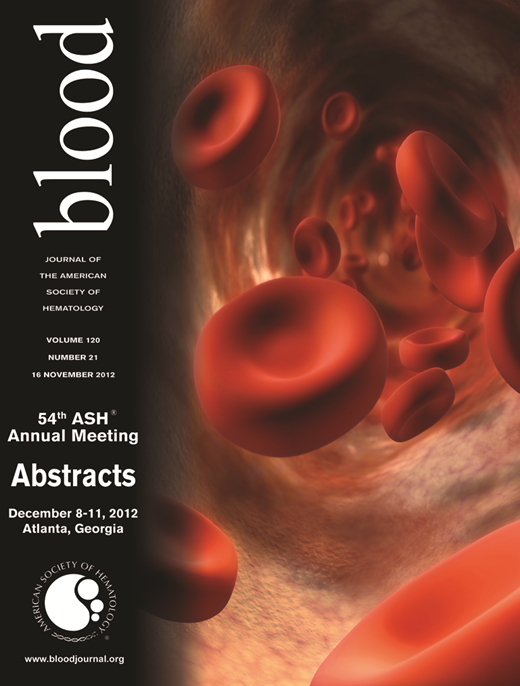Abstract
Abstract 538
The cytogenetic subgroup t(6;9)(p22;q34), previously often reported as a breakpoint in 6p23, is defined as a distinct entity in the 2008 WHO classification of acute myeloid leukemia (AML). The translocation results in a chimeric fusion between DEK at 6p22.3 and NUP214 at 9q34.13 generating the DEK-NUP214 fusion gene. In adults, t(6;9) is associated with young age, very poor outcome, and a higher prevalence of FLT3-ITD than in any other type of AML. To date, the clinical impact of t(6;9) has not been independently described in a pediatric cohort. In this retrospective study, we aimed to characterize the clinical, genetic and morphological features of t(6;9) in childhood AML and to evaluate outcome.
Children aged 0–18 years and diagnosed with t(6;9)-positive AML or MDS within the period January 1, 1993 to December 31, 2011 were included. The presence of the translocation was determined by conventional karyotyping, FISH, or RT-PCR. Patients with Down syndrome and therapy-related AML were excluded. All major pediatric AML study groups were invited to submit clinical data. In addition, diagnostic smears and biopsies were requested for central reviewing and viable cells or RNA for gene expression profiling (GEP). All karyotypes were centrally reviewed and described according to the International System for Human Cytogenetic Nomenclature. GEP was performed on available frozen diagnostic samples from 297 pediatric AML patients including 6 patients with t(6;9). Based on p-value, log-fold change and biological relevance, the following 4 genes were selected for validation by quantitative real-time PCR (RT-qPCR); eyes absent homolog 3 at 1p35.3 (EYA3), sestrin 1 at 6q21(SESN1), PR domain containing 2, with ZNF domain at 1p36.21 (PRDM2, also known as RIZ1), and histone cluster 2, H4a at 1q21.2 (HIST2H4). Validation was performed on 48 patient samples: t(6;9) (n=17), other pediatric AML (n=31) and 14 cell lines including one with t(6;9)(p22;q34).
A total of 58 pediatric patients with a DEK-NUP214 t(6;9) myeloid malignancy from 24 study groups were included in the study: 50 were diagnosed as de novo AML (0.5% of all AML during the study period) and 8 as MDS. Patients with t(6;9) were characterized by a late onset as well as male preponderance; median age was 11 years (range 3–18 years) and the male:female ratio 39:19 (p<0.01). The median white blood cell count (WBC) was 15.6×109/L (range 0.2–191). Bilinear dysplasia with pseudo-Pelger-Huët cells was commonly seen (92% of reviewed evaluable material), and Auer rods were reported in 10 patients, whereas basophilia, in contrast to adults, was absent in this pediatric cohort. FAB-M2 dominated (45%), followed by M4 in 24%. The t(6;9) was the sole cytogenetic abnormality in 81%. Trisomies 8 and 13 constituted 40% of the additional aberrations, either alone or together. FLT3-ITD was present in 44% (n=11) of the cohort with known FLT3 status. The 5-year OS for AML and MDS was 55% and 86%, 5-year EFS was 33% and 56%, respectively. Presence of FLT3-ITD had a non-significant negative effect on OS: 32% for FLT3-ITD-positive cases vs. 67% for FLT3-ITD-negative cases, (p=0.15). The 5-year OS for patients treated with stem cell transplant (SCT) in 1st complete remission (CR) or with refractory disease (RD) was 82% (n=20) vs. 56% with chemotherapy (n=30), (p=0.10). Children who died within 3 months from diagnosis were excluded from the analysis of SCT vs. chemotherapy. The GEP performed on 6 pediatric t(6;9) positive patients showed a unique signature with 180 significantly differentially expressed genes. High expression of EYA3, SESN1, PRDM2/RIZ1 and HIST2H4, was confirmed by RT q-PCR. The levels of expression were significantly elevated for all 4 genes in the t(6;9)-positive cases compared with other AML subtypes.
In conclusion, we present a large international series of 58 children with DEK-NUP214/ t(6;9)(p22;q34)-positive myeloid leukemia, representing 0.5% of all childhood AML. The cases were characterized by late onset, male predominance, myelodysplasia, and a unique gene expression signature. The 5-year OS was intermediate and substantially better than reported in adults. SCT in 1st CR or in RD did non-significantly improve the OS compared with conventional chemotherapy alone.
No relevant conflicts of interest to declare.
Author notes
Asterisk with author names denotes non-ASH members.

